Coming Soon
Maigret on Screen
Georges Simenon is a man of many impressive records, not least his speed of composition (a book in two weeks), resulting in the phenomenal output of 436 novels and short stories. Of these, more than 100 at least are devoted to his most popular hero, Inspector Maigret, a senior policeman at the Police Judiciaire in Paris.
Matching Simenon’s remarkable productivity is the impressive number of film and television adaptations of his work: more than 300 at the time of writing, including at least 200 featuring the inspector.
Maigret was almost immediately adapted for the cinema, with three films that have remained classics: La Nuit du carrefour (Jean Renoir, 1932), Le Chien jaune (Jean Tarride, 1932) and La Tête d’un homme (Julien Duvivier, 1933). By reducing action and violence – by minimising the importance of plot and replacing it with the dark streets, rainy nights, ordinary lives destroyed by crime – Simenon became an important precursor of French film noir. In these films, respectively, Pierre Renoir, Albert Tarride, and Harry Baur are the first to bring to the screen the character’s iconic hat and pipe and his gruff, laconic persona. Of the three, however, the formidable Harry Baur is the best incarnation of Maigret’s world-weariness and capacity for empathy – as in the scene where he sheds tears for a young colleague shot dead during the investigation.
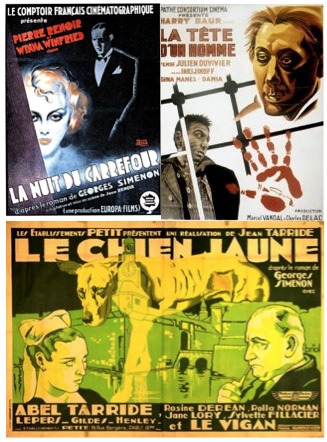
The second wave of Maigret adaptations came during the German occupation with Picpus (Richard Pottier, 1943), Cécile est morte ! (Maurice Tourneur, 1944) and Les Caves du Majestic (Richard Pottier, 1945). Surprisingly at first sight, these work within the light comedy genre typical of thrillers during the war – a time when light escapism was the order of the day.
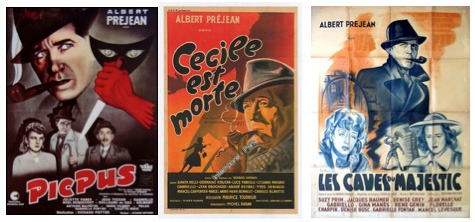
The 1950s see Maigret reappear in a serious register in three films starring Gabin as the inspector: Maigret tend un piège (Jean Delannoy, 1958), Maigret et L’Affaire Saint-Fiacre (Jean Delannoy, 1959) and Maigret voit rouge (Gilles Grangier, 1963). Gabin brought the screen embodiment of Maigret to perfection with his formidable intensity and charismatic solidity; in the Maigret films he just made himself a little heavier, a little more laconic. After Maigret tend un piège, Simenon told the critic Claude Mauriac that his writing ‘might well, from now on, be influenced by this incarnation of his hero’.
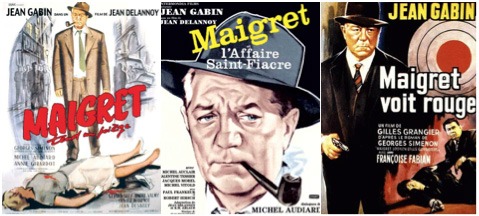
As crime films from the 1960s onwards became more violent, filled with action and exoticism in the wake of James Bond, the world of Maigret suddenly seemed passé. It did not disappear, however. Instead, it moved to television.
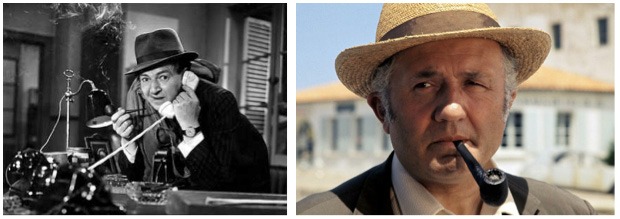
Among the more important series are the 53 episodes (1960-1969) of the British television series starring Rupert Davies; a Dutch series of 17 episodes (1964-1968) with Jan Teulings; 16 episodes of the Italian series (1964-1972) with Gino Cervi, and 88 episodes (1967-1990) in France with Jean Richard.
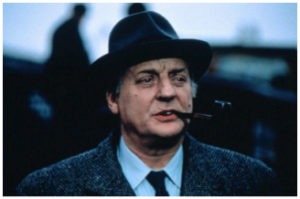 The 1990s marked yet another turning point. Simenon stopped writing in 1981 and died in 1989. The adaptations started to reflect back on to the world of the novels rather than treat them as contemporary. Maigret from then on entered the domain of nostalgia. The two great television adaptations of Maigret shot in the 1990s are a French series starring Bruno Cremer (54 episodes between 1991 and 2005) and a British series starring Michael Gambon (12 episodes in 1992-1993). Stylistically, they exemplify the turn to heritage aesthetics in television: both series are lavish, featuring polished colour photography, beautiful decors and music. The choice of actors goes in the same direction. While Jean Gabin and Gino Cervi, among others, were stars of popular cinema, the actors embodying Maigret in the 1990s came from more rarefied backgrounds: auteur cinema in the case of Cremer and Shakespearian theatre in the case of Gambon.
The 1990s marked yet another turning point. Simenon stopped writing in 1981 and died in 1989. The adaptations started to reflect back on to the world of the novels rather than treat them as contemporary. Maigret from then on entered the domain of nostalgia. The two great television adaptations of Maigret shot in the 1990s are a French series starring Bruno Cremer (54 episodes between 1991 and 2005) and a British series starring Michael Gambon (12 episodes in 1992-1993). Stylistically, they exemplify the turn to heritage aesthetics in television: both series are lavish, featuring polished colour photography, beautiful decors and music. The choice of actors goes in the same direction. While Jean Gabin and Gino Cervi, among others, were stars of popular cinema, the actors embodying Maigret in the 1990s came from more rarefied backgrounds: auteur cinema in the case of Cremer and Shakespearian theatre in the case of Gambon.
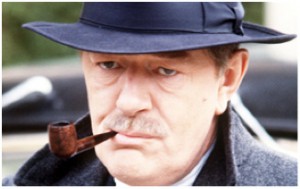 The moment when Maigret adaptations started celebrating the cultural heritage and local colour of the stories coincided with the fashion – dictated by financial considerations – for shooting in central Europe. Accordingly, the French series was shot in Prague, the British in Hungary. As a consequence both look strangely de-located, despite the careful admixture of stereotypically French details (Citroën cars, cigarettes, berets and baguettes).
The moment when Maigret adaptations started celebrating the cultural heritage and local colour of the stories coincided with the fashion – dictated by financial considerations – for shooting in central Europe. Accordingly, the French series was shot in Prague, the British in Hungary. As a consequence both look strangely de-located, despite the careful admixture of stereotypically French details (Citroën cars, cigarettes, berets and baguettes).
As with the earlier adaptations, the Maigret television series of the 1990s continued to affirm their Frenchness through their difference from American and European crime series, which, from the 1990s, become more violent (including obligatory scenes at the morgue), but also made an effort to modernise the police – for instance by including women and people from ethnic minorities. Against this background, Maigret definitely seems to belong to the past, and even the term ‘commissaire’ is dated. Over a wide variety of films and television series, Simenon’s hero has become an archetype, a mythical universal figure deeply reassuring in its stability. Like his British equivalent, Sherlock Holmes, Maigret is a classic national hero, deeply steeped in history yet also able to cross time and space.
Adapted from an original piece by by Ginette Vincendeau, Professor in Film Studies at King’s College London.
ITV recently announced two new Maigret adapatations, Maigret Sets A Trap and Maigret’s Dead Man, which will star British actor Rowan Atkinson. The two films will be set in 1950s Paris. Rowan Atkinson explained, “I have been a devourer of the Maigret novels for many years and I’m very much looking forward to playing such an intriguing character, at work in Paris during a fascinating period in its history”. We can’t wait to see Maigret back on our screens!
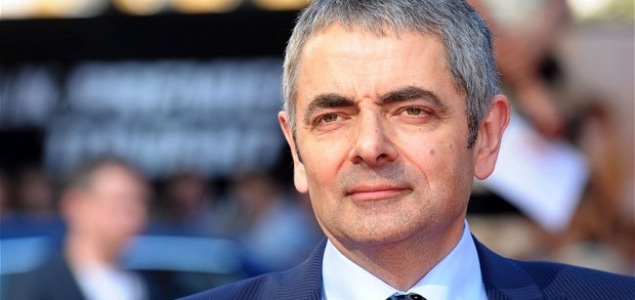
2 Comments
Join the discussion
Please note: Moderation is enabled and may delay your comment being posted. There is no need to resubmit your comment. By posting a comment you are agreeing to the website Terms of Use.

Nice to discover this review of screen Maigrets. Just watched my first Bruno Cremer after enjoying the Rowan Atkinson, loving the Michael Gambon, and having been brought up with the Rupert Davies. Thank you.
Gino Cervi’s Maigrets are sensational, my favourite Maigret. Andrea Camilleri, the author of Il commissario Montalbano was involved in the production. Superb TV!…